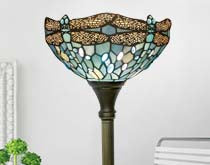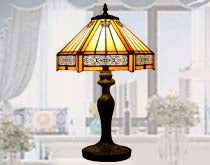Understanding the Switching Mechanism in Tiffany Lamp Designs
The charm of the Tiffany lamps is that it has a different beauty with the light on and off. When the switch of the Tiffany lamp is turned on, you can appreciate its different light and atmosphere.
In the following content, we have introduced you to the different Tiffany light fixture switching mechanisms, and we hope that this will provide you with some ideas when purchasing Tiffany light fixtures.

Basic Structure of Tiffany Lamps
The Tiffany Lamp consists of various components, including the lamp base, lampshade, and of course the switching mechanism. Each component has its own unique function and aesthetic value.

First of all, the lamp base is the core part of the Tiffany lamp, usually made of sturdy metal or fine ceramic, which not only provides solid support for the whole fixture but also adds a touch of vintage flavor. Inside the lamp base are hidden wires that are connected to a switching mechanism to ensure proper transmission of current.
Secondly, the shade is the focal design of the Tiffany lamp. There are many different Tiffany-style lamps on the market, and while there may not be much difference in terms of the materials used for other parts of the lamp, the lampshade is where the craftsmanship and skill are demonstrated. It usually consists of pieces of colored glass that are carefully cut and pieced together to form various patterns and designs.
When the light passes through the Tiffany stained glass lamp, you will surely marvel at the beauty, which gives you not only the lighting effect but also the different sense of ambiance it brings.
Finally, the switching mechanism is an integral part of the Tiffany lamp. It is usually located at the bottom or side of the lamp base and is designed to be both simple and functional. Users can easily control the switch of the lamp with just one press, bringing a cozy atmosphere to the home.
Types of Tiffany Switch Mechanisms
1. Push-Button Switch:
This is one of the most common types of switching mechanisms found in Tiffany lamps. It features a push-button that is either located on the base or integrated into the lamp cord. Pressing the button turns the lamp on or off, providing a convenient and straightforward way to control the light.
2. Pull-Chain Switch:
Another popular option is the pull-chain switch. This type of mechanism has a chain or cord that hangs down from the lamp's base. By pulling the chain, you can toggle the lamp's on/off state. Pull-chain switches are not only functional but also add a vintage charm to the overall design of the lamp.
3. Turn-Knob Switch:
The turn-knob switch is a classic and elegant choice for Tiffany lamps. It consists of a rotary knob that is typically located on the base of the lamp. Rotating the knob clockwise or counterclockwise controls the lamp's on/off function. This type of switch offers a tactile and visually pleasing experience.
4. Touch Switch:
In some modern and innovative Tiffany lamp designs, touch switches are used. These switches are usually located on the lamp's base or shade and can be controlled simply by touching the designated area. Touch switch that is, our modernized design, such as cell phone control, can easily turn on or off the lights with just one touch, improving convenience and efficiency.
How to Choose the Right Switching Mechanism
When selecting the right switching mechanism for your Tiffany lamp, there are a few factors to consider:
Aesthetics: Choose a mechanism that complements the overall design and style of your lamp. Consider whether you prefer a traditional or contemporary look and select a switch that aligns with your aesthetic preferences.
Functionality: Think about how you will use the lamp. Do you prefer the convenience of a push-button or touch switch, or do you appreciate the nostalgia of a pull-chain or turn-knob switch? Consider what feels natural and intuitive for you.
Durability: Look for a switching mechanism that is durable and built to last. It should be able to withstand frequent use without wearing out or malfunctioning.
Safety: Ensure that the chosen switch mechanism meets safety standards. It should be able to handle the electrical load of the lamp and provide a reliable and secure connection.

For different uses of Tiffany lamps
- Tiffany Table Lamps: Since table lamps are usually placed on a table or at night, a zipper switch or knob switch may be the most convenient since they are easy to reach and operate.
- Tiffany Floor Lamps: Floor lamps are usually taller and a foot switch may be the best option as it allows the user to easily turn the light on and off without bending over.
- Tiffany chandeliers: chandeliers are usually hung from the ceiling, so a wall switch or remote control may be the most convenient.
- Wall sconces: Wall sconces are usually mounted on the wall, so a knob or zipper switch or a wall switch that connects to light fixtures in other rooms may be the best option.
Maintenance and Replacement of Switching Mechanisms
Regular maintenance is important on this point, with such a delicate Tiffany lamp, regular maintenance will extend its life. Here are a few maintenance tips for the switching mechanism:
Cleaning: Gently clean the switch with a soft cloth and mild detergent to remove any dirt or dust that may affect its performance. Make sure to disconnect the lamp from the power source before cleaning.
Tightening: Over time, the switch may become loose. Check periodically to ensure that all screws or connections are tightened properly, but be cautious not to overtighten and cause damage.
Replacement: If your Tiffany lamp's switching mechanism is malfunctioning or damaged beyond repair, it may be necessary to replace it. Contact a professional electrician or a reputable lamp repair service to ensure a safe and proper replacement.
Related reading: Tips for maintaining and cleaning Tiffany lamps
Conclusion
The Tiffany Lamp is more than just a lamp; it's art, it's emotion, it's a bright light in life. And the on/off mechanism in it is both the heartbeat of the lamp and adds to its charm.
Did you know? Choosing the right switch will not only make it easier for you to control that lamp, but it will also make it look perfect. So, when you are choosing a switch for your Tiffany lamp, you may want to consider more about its beauty, practicality, durability, and safety.
Remember to perform regular maintenance and seek professional assistance when needed to ensure the longevity and optimal performance of your lamp.
FAQs
When did Tiffany stop making lamps?
Like many trends that ebb and flow, the allure of Tiffany lamps began to wane over time. By the time 1913 rolled around, these once-coveted lamps had vanished from the chic interiors of the day. The factory halted their production, overshadowed by the emerging popularity of Art Moderne and Expressionism.
What is the base of a Tiffany lamp made of?
The foundation of an authentic Tiffany Studios lamp is truly a testament to its exquisite craftsmanship. Crafted from pure bronze, these hollow bases exude a timeless elegance. It's worth noting that during the era when Tiffany Studios was producing these masterpieces, bronze was a prized commodity, both rare and costly. On occasion, one might come across Tiffany lamps with art pottery bases, but such instances are few and far between.
Related reading: Common Materials for Tiffany's Lamp Bases























